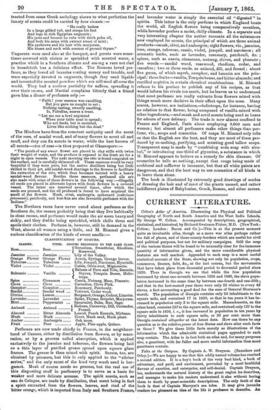CURRENT LITERATURE.
Colton's Atlas of America. Illustrating the Physical and Political Geography of North and South America and the West India Islands. By George W. Colton. Accompanied by descriptions, geographical, statistical, and historical, by Richard Swainson Fisher, M.D. (New York : Colton ; London : Bacon and Co.)—This is at the present moment quite an invaluable atlas, though as a mere war atlas perhaps rather too full of places, and of those county-borders which are useful for civil and political purposes, but not for military campaigns. Still the map of the various States will be found to be unusually clear for the immense quantity of information given, and the more considerable physical features are well marked. Appended to each map is a most useful statistical account of the State, showing not only its population, crops, commerce, finance, debt, &c., at the last census, but the movements that have taken place from decennial period to decennial period since 1820. Thus in Georgia we see that while the free population increased by about one-seventh between 1850 and 1860, the slave popu- lation increased in the same time by between one-fourth and one-fifth ; and that in the last-named year there were only 55 whites to every 43 slaves, a fact accounting a good deal for the ease of General Sherman's march. The population of Georgia contains only 20 inhabitants to the square mile, and contained 17 in 1850, so that in ten years it has in- creased in population only 3 to the square mile. Massachusetts, on the other hand, contains 157 to the square mile, and contained only 127 to the square mile in 1850, i. e., it has increased in population in ten years by thirty inhabitants to each square mile, or 50 per cent. more than Georgia contained altogether at the latest date. How can there be any question as to the relative power of free States and slave after such facts as these ? We give these little facts merely as illustrations of the information which the admirable statistical pages appended to each map contain. The Atlas is in fact both en atlas and, for many purposes also, a gazetteer, with far fuller and more useful information than most gazetteers contain.




































 Previous page
Previous page